|
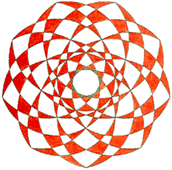
|
Remo F. Roth
Dr. oec. publ., Ph.D.
dipl. analyt. Psychologe (M.-L. v. Franz)
|
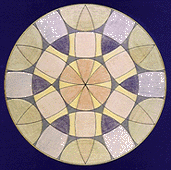
|
©
2003 by Pro Litteris, Zurich, Switzerland and Remo F. Roth,
Horgen-Zurich. All Rights Reserved. dr.remo.roth@psychovision.ch.
Republication and redissemination of the contents of this screen
or any part of this website are expressly prohibited without
prior psychovision.ch written consent.
With
many thanks to Gregory Sova, Ph.D. (LA, CA) for translation
assistance
The
New Mysticism and the Life after Death
Contents:
part
1:
1.
What Is Mysticism?
2.
The Conflict of the Mystics with the Clerics
3.
The Mysticism of the World Religions
4.
Identity Mysticism and Relationship Mysticism
5.
Carl Jung’s Collective Unconscious and the New Mysticism
6.
An Example: The Mysticism of the Swiss Saint Nicholas
von Flüe
7.
The Mysticism of Alchemy
part
2:
8.
The alchemical myth of God’s transformation and redemption
The
New Mysticism and the Life after Death
Lecture,
of 6/6/1997
at
C.G. Jung Institute,
Stuttgart,
Germany
Part
I
1.
What is Mysticism?
As
the title of my lecture indicates, today we are occupied with
mysticism on the one hand, i.e., with a new kind of mysticism, and
on the other hand with conceptions about the life after death.
In
the first part I will give you an introduction to the new
mysticism. In a second part we are then occupied with the topic of
a possible life after death. These two topics have a close
relationship. This is the reason why I choose to discuss them
together.
If
I tell you of a new mysticism, I must first explain, what
mysticism actually is. Etymologically regarded the word mysticism
comes from the Greek myein,
i.e., "closing the eyes." Mysticism thus primarily means a
mental condition, in which one withdraws oneself from the outside
world and in an act of introversion turns inward, by closing eyes,
ears and mouth.
In
addition mysticism always refers to something divine. Together
with the above etymological derivative we can therefore conclude
that mysticism represents an occupation with God or with the
divine in oneself. A mystic is thus occupied with images and
voices, which come out from the inside; the direction of motion is
thus from inside to outside.
These
circumstances are very beautifully represented in a vision of the
Swiss mystic Nicholas von Flue (more about his life
see www.psychovision.ch/rfr/radbilde.htm)
(see figure 1).
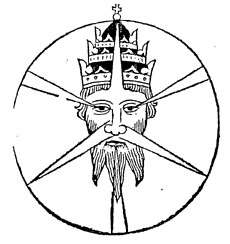
Figure
1: The Frightening Vision of God’s Face
In
this vision Nicholas sees the face of God, whose eyes ears and
mouth are each pierced by a spear tip. If one imagines this very
concretely, one comes to the conclusion that the challenge of such
a human is it to close the ears, the eyes and the mouth for the
purpose of not listening, not looking and not speaking anymore to
the outside. Such a human is thus forced to become a mystic, i.e.,
to turn to one’s own interior world. If one follows this
process, it will proceed from the inside outward – as the second
three spear tips in Nicholas’s vision. They point from the head
outward, thus from the inside outward.
With
this symbolism the process of a mystic is very beautifully
described: They turn inward, by closing mouth, eyes and ears, from
which one experiences that something flows from the inside
outward. This flow corresponds to the visions seen during the
mystical process.
However,
in the image it is actually God whose "extraverted sensation
organs" are pierced. This means that the ability to meditate and
to become a mystic rises from a divine center in the human soul. Nicholas
thus became pulled into this divine inner process, so that
in the long run he was not able to do anything else but live the
life of a mystic.
2.
The Conflict of the
Mystics with the
Clerics
Here
a serious problem of the mysticism of all religions immediately
shows up. Since mystics perceive a God-image, which emerges from
their inside and takes the form that reflects the very individual
roots of the persons religious background, it can differ from the
dogmatically proclamated image of God. Thus for example the
Christian mystic Cusanus (Nicholas of Kues) described God as a coincidentia oppositorum, a union of all contrasts in God. A
necessary conclusion from this fact is that God includes both good
and evil. This contradicts the Christian God-image, which
proclamates that God is pure love, and in Him there is no evil at
all.
Thus
conflicts naturally develop between the mystics and the teachings
of the clerics, which regard the theology and teaching of the
dogmatism of a specific God-image as their occupation. This
conflict is still with us very much yet today. In the year 1945
about 50 lost Gnostic gospels were discovered in Nag Hammadi in
Egypt. Since
then we know that there are many further gospels beside the four
Canonical gospels
(see Pagels, Elaine: The
Gnostic Gospels).
In these gospels, written in the tradition of Christian mysticism,
Jesus Christ is somewhat differently represented than in the four
official gospels. But although these Gnostic gospels are already
published for more than twenty years, they are not taken by the
Christian theologians as part of their knowledge. The dogmatism of
the Church does not want to have anything to do with these
mystical Gnostic gospels.
The
mystic experiences the divine by the looking within, by a deep
state of introversion. Like this he experiences a very individual
God-image. As we will see, it is exactly this experience of the
divine which connects one to ones own roots, and which gives new
meaning to ones life.
The
cleric does not know this experience therefore he/she must replace
direct experience by a faith in contents of the holy writings,
which is frequently defended with fanatical zeal. Symbolically
speaking clerics do not close their eyes, but keep them open, in
order to be able to read the contents of these holy writings. They
are thus deeply occupied with the outside or an extraverted
religious experience.
3.
The Mysticism of the
World
Religions
Mysticism appears in all of the world religions. Their mystics
form an introverted counter pole to the extraverted clerics, who
concern themselves with the interpretation and distribution of the
holy writings.
Christian
mysticism begins in the 11th Century with Bernhard von
Clairvaux who was, indeed, also the initiator of the first
crusade. Christian mysticism becomes in the centuries after
Bernhard von Clairvaux an eminent German affair. It culminates and
degenerates finally in the Sacred Heart of Jesus Mysticism.
However,
the most important Christian mystics hushed up by the official
church are the alchemists, to whom we will return later. For the
moment I will only make reference to the fact that the alchemists,
for example Paracelsus, looked for the Deus
absconditus, the hidden God in ones own soul. This is also the
deeper reason, why C. G. Jung was occupied so intensively with
alchemy (see: Jung, CG: Psychology
and Alchemy, CW 12, Princeton University Press, 1978).
Jewish
mysticism is laid down in the writings of the Kabbalah (see: Gershom
Sholem: Major Trends in Jewish Mysticism).
Here the divine is represented as an abstract tree, the famous
Sefiroth tree. In addition a highly differentiated number
mysticism belongs to the Kabbalah. The number becomes therein the
carrier of the characteristics of the divine. It is not only used
for counting and paying, but each number is imbued with a certain
quality. For example the number nine symbolizes the transcendental
world and thus also the mysticism, because nine is a threshold
number that allows for the transition to a new world, i.e., to the
world of the two digit numbers (10 to 99).
The
Muslim, the followers of Islam, also possess their own kind of
mysticism, Sufism. This mysticism is one of the greatest and
richest of all (see Schimmel, Anne-Marie: Mystical
Dimensions of Islam). Last but not least we also know about
the mysticism of Buddhism and Hinduism, i.e., Tantrism, which is
so well known today.
In
addition mysticism occurs in areas that have, at first glance,
nothing to do with religion. Quantum physics, the physics of the
subatomic elementary particles, is some sort of a projected
mysticism. This is why the physicists find structures in the
macrocosm, which are very similar to the God-images the mystics
see in their microcosm. (see Roth, Remo F.: Die
Gottsucher – Eine Vereingiung der Christlichen Mystik und der
Quantenphysik in der Synchronizität C.G. Jungs,
Frankfurt
a/M.,
1992; in German).
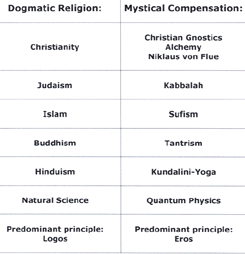
Overview
1: The World Religions and their Mysticisms
If
one now asks oneself, what humans of today who are close to
Esoterics are looking for, then it is noticeable that very many
occupy themselves with Sufism, Tantrism and the Kabbalah.
Obviously they look for a way that will satisfy their need for
mystical experience. However, they again, in a typically Western
fashion, look outside for finding this experience, i.e., they are
fascinated by a mysticism of some exotic religion outside their
cultural roots.
Therefore,
little attention is given to the mysticism of our own roots, the
Medieval alchemy.
4.
Identity Mysticism and
Relationship
Mysticism
In
most general terms we can propose that to be a mystic means to be
occupied with the divine in one’s own soul. Here we must now
differentiate two completely different kinds of mysticisms that
appear in the world: mysticism through identification and
mysticism through relationship.
In
the mysticism by identification the mystic tries to become like
the divine or become God. So for example the Buddhist Tantrism is
identity mysticism. The Tantrist would like to become identical
with the "nothing", with the Nirvana, which in his case is the
divine principle.
Today,
the identity mysticism is - especially since the physicist Fritjof
Capra has brought it together with quantum physics – the
preferred way in the Esoteric mainstream. It possesses however a
very dangerous aspect for us Western humans. Due to our
psychological conditions we are not prepared to become divine or
God-like. An identity mystic, who has a God experience, is in the
danger of falling into a so-called inflation (Carl Jung), i.e., a
megalomania. Such humans transform into a god-like being, like
this blow themselves up and begin with missionary zeal to preach
their latest revelation. A new guru is born…!
The
contrast to the identity mysticism is the relationship mysticism.
We find the relationship mysticism in all three Semitic religions:
in the Jewish Kabbalah, in the Muslim Sufism and also the in
Christian mysticism. They all are stamped by the fact that the
mystic looks for a relationship with God or with
the God-image hidden within themselves. This mysticism is also
called Ich-Du-Mystik (English translation: I-You-Mysticism)
Therefore, a Christian or Sufi mystic would never say, that they
have become God (as the identity mystic does), but instead
stresses the relationship aspect. Such a mystic remains human and
does not identify with the divine.
Without
any exception the human heart is the location for this
relationship with God the relationship mystic tries to reach. This
evening we want, therefore, to be occupied with the relationship
mystical experience.
5.
Carl Jung’s Collective
Unconscious and the New Mysticism
Why
do I use the term "new mysticism?" In order to clarify
this circumstance, we also must now include the discoveries of the
depth psychology.
All
depth psychological theories rely on the use of the term
unconscious. Historically Sigmund Freud is credited with the
discovery of the unconscious. The use of the word "unconscious" means to imply that it is all the contents of
which I am not conscious. This means that there exists another
realm in my soul, about which I do not actually know anything
about and I am therefore unconscious of it. Thus, the unconscious
is first a mere hypothesis.
The
revolution created by the founder of depth psychology, Sigmund
Freud, was the fact that when he published his Traumdeutung
(Dream Interpretation)
in the year 1900, for the first time someone began to deal with
dreams empirically.
This means that he recognized that the subconscious realm of the
soul can have observable
effects on consciousness. One can notice the
effects of the unconscious on the conscious, and therefore its
existence is proven exactly by this observation. This method is
the usual procedure of natural science; therefore Sigmund
Freud’s empirical proof of what he called the subconscious was
the first time that psychology began to deal with the unconscious
in the way of natural science’s methodology.
The
most famous example today of such an effect of the unconscious on
the conscious are the so-called Freudian slips of the tongue
(Freudian slip). One would like to say something, but an
unconscious complex interferes, and one says a different thing.
Sigmund
Freud assumed that all that is unconscious was once conscious.
These contents became unconscious by forgetting or repression –
the latter being the most important term of Freudian psychology of
today. Above all unpleasant things, negative feelings, the bad
conscience, and especially
sexual fantasies in Freud’s
Vienna
of the 19th
century were all repressed. Freud’s unconscious is therefore a
kind of trash can for all these unpleasant thoughts and fantasies
(see figure 2).
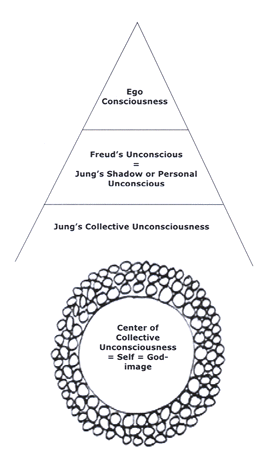
Figure
2: The structure of the psyche after Freud and Jung
In
the terminology of Carl G. Jung the Freudian unconscious
represents the so-called personal unconscious or the shadow.
Already Sigmund Freud noticed however that there are dreams, which
contain so-called "archaic vestiges". These contents of "archetypal dreams" (Carl Jung) cannot be explained out of the
personal psychology of the dreamer. In other words they concern
dream contents, which did not develop due to a repression into the
unconscious, but must have been contents since eternal times.
So
C .G. Jung, for example, saw in the dreams of a psychotic patient
at the Burghoelzli psychiatric hospital the motif of a sun
phallus. The patient told again and again of this image of the
sun, which had a hose that hung down to the earth. This is a
motif, which occurs only in the Gilgamesh Epic, a Babylonian
mythological legend, which had not yet been translated at that
time into a Western cultural language. The dreamer could thus know
nothing of it, and yet the motif appeared nevertheless in the
patient’s dreams and fantasies. Due to these and similar general
human experiences – especially also his own - Jung saw that
under the personal unconscious discovered by Freud (his
subconscious) there had to be a deeper layer. Jung called it the
collective unconscious. Its contents are collective in the sense
of the fact that they concern thereby mankind-specific ideas,
which always were in the unconscious and therefore could not have
resulted from repression. These contents Jung called archetypes.
[Remark
of November 11th, 2003: Later,
in the year 1946, Carl Jung expanded on the meaning of the term
archetype. He then defined it not only as the structural dominant
of the collective unconscious, but also as having a psychoid
aspect, as being a part of a world behind or beyond it. This world
he called the unus mundus,
the united world of matter and psyche. Its empirically observable
content is what he called synchronicity.]
Under
the archetypes one imagines usually something unbelievably
complicated. To get an alive conception of an archetype, there
exists however a very simple procedure: If one remembers a dream,
which occurred many years or decades ago, then it is in all likely
hood a dream out of the collective unconscious, in which such
"archaic vestiges" or archetypal motifs spring up. As an
example, I would like to mention the archetype of the nourishing
principle or the positive mother archetype, which can be
represented in these dreams by many different pictures such as for
example the tree, the cave, the toad, the turtle, the dinosaur,
and so on.
In
the works of Carl Jung one sees that what he calls the collective
unconscious is really something numinous. Behind this numinousness
the divine hides itself. Thus for him the collective unconscious
possesses god-like qualities. We must however keep in mind that
Jung never speaks of God or of the divine. This concept of the
theologians is a metaphysical one, and therefore no subject of an
empirical science. To describe this deepest archetype of his
analytical psychology, he uses the term the God-image. In contrary
to the metaphysical god of the theologians the God-image is the
empirically observable image in our soul. This God-image can
differ from the canonized, i.e., from the image Christians have of
their God, and is – as Jung noticed in thousands of dreams –
represented by a symmetric mandala structure.
Therefore,
for Carl Jung the center of the collective unconscious is the
(individual) God-image. One of the most important tasks of the
so-called individuation process he defined as the challenge of our
life, is thus to find this inner God-image in one’s own soul and
to find the right individual relationship to it.
The
graphic representation of the collective unconscious looks thus
about as shown above (see figure 2): The main archetype, the
God-image, is placed in the center and around it are grouped its
many different characteristics, the other archetypes of the
collective unconscious.
And
now you understand why I speak of the new mysticism. If the
collective unconscious possesses divine qualities and the center
of it even corresponds to the individual inner God-image, an
occupation with the archetypal dreams and visions of the
collective unconscious emerges as an inner relationship with the
divine. This relationship with the divine in one’s own soul
represents however mysticism in the broadest sense of the word.
We
know from the history of the mystics - above all from the feminine
mystics – that the content of their visions and dreams from the
collective unconscious were modified by their confessors. All
visions, which were not compatible with the official church
doctrine, were condemned as a whispering of the devil.
Thus most of the visions of Christian mystics have been
falsified and thus cannot be used to compare with today’s
mystical experiences.
However,
the visions of the Swiss saint Nicholas von Flue are an exception.
Since he did not live in a monastery, the clerics did not have any
power over his visions. And his life as a simple Swiss farmer
likewise protected these visions from the know-it-all dogmatic "wisdom" of the clerics. It is to be owed to these
circumstances that we have his visions in the original and thus
unpurified form. As Marie-Louise von Franz has shown, in them the
whole Germanic mythology lays hidden (see Marie Louise von Franz: Die
Visionen des Niklaus
von Flüe, 2nd ed., Daimon,
Zurich,1980; to
be published in English).
In
the history of the mystics it was thus tried again and again to
force the contents of their visions to agree with the dogmatic
teachings of the Church’s God-image. The real new aspect of the
mysticism I suggest consists therefore – in contrast to the
procedure of the censorship practiced by the Christian clerics -
in an objective and unbiased encounter with the visions and
archetypal dreams emerging from the collective unconscious. In
this way confessing Christians discover perhaps in their
unconscious a Tantric God-image
and they will have the task to combine the Christian God-image
with the Tantric. Or convinced Christians find in the collective
unconscious remnants of the Jewish God-image, which they must now
bring in agreement with the Christian, and so on.
6.
An Example: The
Mysticism of the Swiss
Saint
Nicholas
von Flüe
Briefly
said the new mysticism consists in a completely unprejudiced way
of dealing with one’s visions and dreams from the collective
unconscious and trying to understand of which individual God-image
they speak. More than 500 years ago this was the burden the Swiss
mystic Nicholas of Flüe had to bear (see also The Wheel Image of
Nicholas von Flüe).
Already
in his youth he was overwhelmed by visions that spoke of a
God-image which greatly differed from the approved Christian view.
We see this fact again in the vision of the frightening face of
God (see figure 1). In his consciousness Nicholas of Flüe believed
that there were three persons in one God, in the so-called Holy
Trinity. This means that God consists of the three male persons;
God the father, God the son and God the Holy Spirit. However, in
the collective unconscious of Nicholas a completely different
God-image was constellated, i.e., one that corresponded to a
double trinity, which is symbolized by the two groups of three
lance points pointing in opposite directions. During an inner
process of several years, Nicholas transformed this vision in his
today famous image of the wheel (see figure 3).
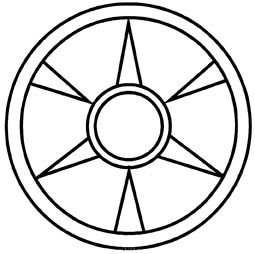
Figure 3: The Wheel Image of Nicholas
von Flüe
Besides
the very undogmatic double triadic structure, in Nicholas’
renewed God-image and apart from the Holy Spirit a goddess also
appears. Nicholas’ image of the wheel corrects therefore the
Christian God-image and supplements it with the feminine
principle, which had been excluded by the church fathers. Nearly
500 years later Pope Pius XII proclaimed the dogma of the
Assumptio Mariae, the dogma of the corporal ascension of the God
mother Maria – and was laughed at by most theologians. For Carl
Jung this acknowledgment of the female as divine principle was
however a large hope for the spiritual future of the Christian
world.
[Remark
of
November
11th, 2003
:
In
the year 1953 the physicist and Nobel laureate Wolfgang Pauli
criticized the Assumptio
in a letter to Carl Jung [Atom and Archetype, letter [58], p.
84-101] as a Neoplatonic procedure and therefore criticized also
Jung, who compared the Assumptio with the quaternarian archetype of the Self, he defined as
the center of the collective unconscious. Pauli argued that by
this procedure it was only "disinfected matter", i.e., a
defective feminine principle, which was liberated and sent to the
Christian Heaven. Like this, he argued, matter, the archetypal
feminine principle, was not transformed in concordance with
Hermetic alchemy.
In
Hermetic alchemy there existed a symmetry between matter and
spirit: In the so-called coniunctio,
the sexual union of the God and the Goddess as the final process
of the Hermetic alchemical opus, the latter was first defined as
an anti-trinity, too. Second, it transformed into the masculine
divine principle as well as the trinitarian masculine into the
feminine. By this procedure an "intermediate reality" was
created (and not the all spiritual principle of Neoplatonic
alchemy), out of which the incarnatio,
the incarnation of the so-called infans
solaris (the sun’s child) or the extraction of the red
tincture happened. This red tincture Pauli compared with an
extended comprehension of radioactivity, seen on a deeper,
psychophysical level which is itself the unus mundus, the (empirically observable) psychophysical reality out
of which new creation (i.e., newly animated matter) is born. As I
have shown elsewhere, this today created newly animated matter are
the UFOs and their inhabitants, encounter and abduction victims
experience as a subtle body reality in their mind and body.]
Nicholas
von Flue spent nearly his whole life with the confrontation with
this novel God-image constellated in the collective unconscious,
which compensated the Christian Trinity that he consciously
believed in. Likewise today there are already many humans, in whom
such new God-images are constellated. Since the dreams and visions
from the collective unconscious speak an enigmatic and dark
language, they cannot be easily understood without a certain skill
and a deepened knowledge about the symbols they contain. Therefore
modern humans search on the outside and let the treasures of their
own soul go unacknowledged. This is the deeper reason why so many
people imitate today far Eastern mysticism and the related
meditation techniques.
But
more and more humans begin to understand that the real wisdom
comes from the inside, and that the deepest meaning of one’s
life lies in recognizing the individual God-image constellated in
the deepest regions of one’s own soul. This is only possible by
searching after it in one’s own dreams and visions. Like this
these humans become the mystics of our time. They work – all of
them in their own way – at trying to consciously realize the
individual God-image of the 21st century.
7.
The Mysticism of
Alchemy
At
the beginning of my lecture I mentioned that alchemy represents
the mysticism of Christianity (see also Paracelsus
and the Renewed God-Image). It is hardly amazing therefore that in
dreams and visions of my client’s, symbols arise again and
again that relate to the alchemical process of God’s
transformation. It seems that more and more humans today have the
task to understand and consciously reconstruct this alchemical
process and its goal. In the following I would like therefore to
show to you this inner spiritual process of the transformation of
the God-image.
Before
I can deal with this extremely heretical alchemical myth I must
first try to rectify the widespread prejudice concerning the
ancient practice of alchemy. Today most humans still believe that
alchemy was about the making of gold in the Middle Ages. This
uninformed belief holds that the nature of alchemy consisted in
the attempt of certain people who tried, with the use of base
metals, for example with lead or copper, to make gold. Carl Jung
proved that this is a great misunderstanding. Of course, there
were money-greedy alchemists, who really believed that they could
make gold in any mysterious kind. But the more intelligent among
them saw however the Opus, the alchemical work, as a symbolic
task. The making of gold was a symbolic expression for the "creation" of the divine, thus of the indestructible, the
incombustible, the eternal. Basic material for the divine was
thereby the prima materia, which itself was hidden in
matter. Especially the physicians under the alchemists, especially
Paracelsus and his student Gerhard Dorn (Gerardus Dorneus) thought
it to be in the human body out of which the so-called subtle body,
a divine principle, had to be created. By the way I would like to
point out that this alchemical idea corresponds completely to the
central idea of the Buddhist and Hindu Tantrism.
I
want to show you by the following example how these alchemical
motifs can spontaneously emerge in the dreams of modern humans.
During a very critical phase of life one of my clients experienced
the following vision:
I
am with a fairy in a
round village square. I am brought here and tied to a stake in
order to be burned. In burning, my body transforms into a dove and
flies away.
Some
humans who hear of this vision will most likely assume that it
talks of Reincarnation. My client would assume in this case that
she would have been burned in an earlier life, during the
so-called witch hunt, because she believes in Reincarnation.
Whether this interpretation applies or not, one will never be able
to prove empirically. The Reincarnation idea will always remain a
speculation. It is a matter of the personal choice if one believes
in it or not. Further, in the above vision this interpretation
does not explain the motifs of the fairy and of the dove.
If
one now instead accepts that this vision originates from the
timeless and spaceless realm of the collective unconscious –
which by definition cannot be in the past of mankind but is what I
call the always/everywhere – then one
could try to understand this product of the unconscious with the
help of the empirical based interpretation method of C.G. Jung.
Thus one could ask oneself, what is the task in the here and now
and what future prospects are described by this vision. In such a
manner we refer such archetypal dreams and visions to the present
and a future task and challenge of the humans concerned. The
question thus does not read, what could this vision say about an
earlier life, but rather one asks oneself, what could it mean for
the here and now and the future of the visionary. In this way also
the past is however consulted for the purpose of inquiring what
the motifs in the vision or dream could have meant in earlier
days.
To
find out about this task for the here and now, I apply the
so-called amplification method of Carl Jung. In it one searches
for parallels to the dream or vision motifs in the history of
mankind. If one finds out, what at that time these parallel motifs
meant, one can understand also the deepest sense of an archetypal
dream or of a vision for the present and the future of humans
concerned.
Since
this aspect is very important, I want again to briefly point out
the difference between Reincarnation theory and the approach I
call new mysticism. Representatives of the Reincarnation
hypothesis refer such dreams and visions, like the above-mentioned
burning at the stake, to an earlier life. For Carl Jung however in
them archetypal motifs are described, which want to teach the
individual concerned something about his/her future development.
Jung thus refers such a dream to the here and now and to the
future, includes however the past with the help of the
amplification of the dream’s or vision’s contents.
Applying
Jung’s amplification method for understanding our vision, one
sees that the motif of the fire that does not destroy belongs to
the famous
Phoenix
myth.
Therein the
Phoenix
bird burns
itself and its nest up by its own body heat. From its own ashes it
is born again and is now immortal.
The
main goal of alchemy is also this production of the indestructible
and the immortal, the "gold". However, in the vision of my
client a dove emerges from the ash. Obviously this dove represents
the goal of her current life. The dove is a symbol of the Holy
Spirit on the one hand, and on the other an attribute of the
Greek-Roman goddess Aphrodite/Venus. Thus the vision is concerned
with a divine female spirit, which arises from the ash of the
burned body. Since this spirit is connected with the goddess
Venus/Aphrodite, it seems to be substantially connected with the
Eros principle. The vision tells us therefore that the process of
the new mysticism consists for this woman in the challenge of
liberating the Eros principle out of her physical body.
After
the break
we will see that this divine female principle is on the one hand
the so-called World Soul (anima mundi), on the other the
subtle body. In addition it will become clear how the redemption
of the World Soul and of the subtle body are connected with the
new mysticism.
[Break]
part 2
see
also
Some
Thoughts about the Relationship of Carl Jung’s Depth Psychology
to Quantum Physics and to Archetypal Psychosomatics
Neotantrism
and Body Centered Visualization
A
Body Centered Visualization for
Arrhythmias
of the Heart
English
Homepage Remo F. Roth
back

|